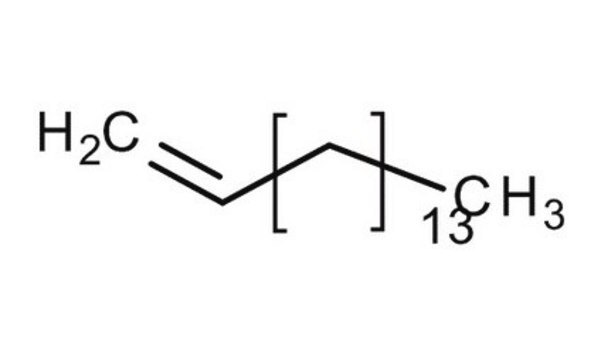H2131
1-Hexadecen
≥98.5%
Synonym(e):
Ceten
About This Item
Empfohlene Produkte
Dampfdichte
>0.8 (vs air)
Qualitätsniveau
Dampfdruck
<0.2 mmHg ( 20 °C)
Assay
≥98.5%
Form
liquid
Selbstzündungstemp.
464 °F
Brechungsindex
n20/D 1.441 (lit.)
bp
274 °C (lit.)
mp (Schmelzpunkt)
3-5 °C (lit.)
Dichte
0.783 g/mL at 25 °C (lit.)
SMILES String
CCCCCCCCCCCCCCC=C
InChI
1S/C16H32/c1-3-5-7-9-11-13-15-16-14-12-10-8-6-4-2/h3H,1,4-16H2,2H3
InChIKey
GQEZCXVZFLOKMC-UHFFFAOYSA-N
Suchen Sie nach ähnlichen Produkten? Aufrufen Leitfaden zum Produktvergleich
Verwandte Kategorien
Allgemeine Beschreibung
Anwendung
- Development of petroleum lubricating oil additives: A study evaluated newly synthesized copolymers and their montmorillonite nanocomposites as cold flow improvers for petroleum lubricating oils, including formulations with 1-Hexadecene, demonstrating enhanced flow properties (El-Bahnasawi et al., 2023).
- Attractants for biocontrol agents: Research identified volatile blends containing 1-Hexadecene that attract the biocontrol agent Galerucella placida, suggesting applications in agricultural pest management (Koner et al., 2022).
- Adsorbent materials for oil spill cleanup: A study explored the modification of commercial sponges with 1-Hexadecene-based polymers for efficient adsorption of crude oil and organic solvents, highlighting potential environmental cleanup applications (Jin et al., 2022).
- Surface engineering for hydrophobicity: 1-Hexadecene was used to create organosilane micropatterns on surfaces, improving their hydrophobic properties, relevant in material science and surface engineering (Soliman et al., 2021).
Signalwort
Danger
H-Sätze
Gefahreneinstufungen
Asp. Tox. 1
Lagerklassenschlüssel
10 - Combustible liquids
WGK
WGK 1
Flammpunkt (°F)
269.6 °F - closed cup
Flammpunkt (°C)
132 °C - closed cup
Persönliche Schutzausrüstung
Eyeshields, Gloves
Hier finden Sie alle aktuellen Versionen:
Besitzen Sie dieses Produkt bereits?
In der Dokumentenbibliothek finden Sie die Dokumentation zu den Produkten, die Sie kürzlich erworben haben.
Kunden haben sich ebenfalls angesehen
Unser Team von Wissenschaftlern verfügt über Erfahrung in allen Forschungsbereichen einschließlich Life Science, Materialwissenschaften, chemischer Synthese, Chromatographie, Analytik und vielen mehr..
Setzen Sie sich mit dem technischen Dienst in Verbindung.









